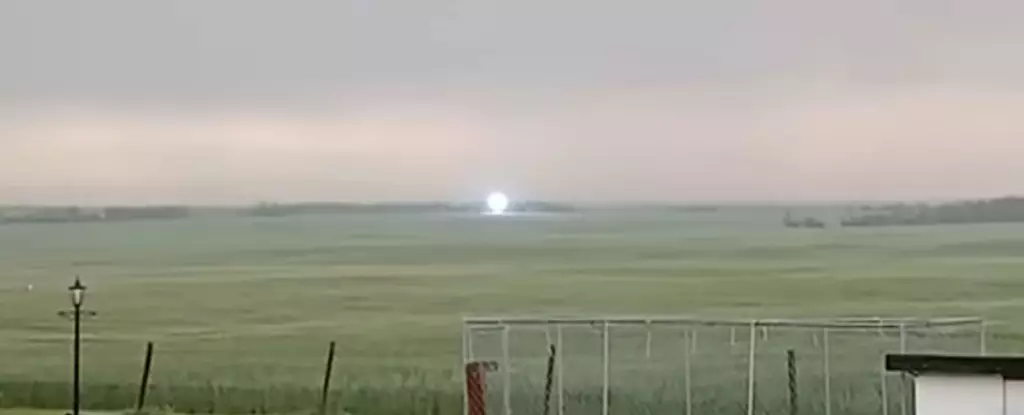Recent events captured by the Pardy couple from Canada have ignited a renewed sense of wonder and curiosity about weather phenomena that challenge our understanding. During a thunderstorm, a lightning strike less than a kilometer from their porch produced an extraordinary visual spectacle—a glowing blue orb that lingered momentarily before vanishing with a pop. This rare footage, lasting only 23 seconds, has stirred debates across scientific and enthusiast communities alike. While the couple’s narrative and recorded evidence are compelling, they also highlight the limits of conventional atmospheric science when faced with truly anomalous phenomena. The image of a hover-like sphere defies typical lightning patterns, suggesting that some atmospheric events remain poorly understood, or perhaps even entirely undiscovered.
The Crucial Question: What Was It Really?
The reaction to the footage underscores a broader issue: the difficulty of definitive identification of unexplained lights. The observed object was spherical, blue in hue, and persistent enough to be photographed and filmed. Its size—roughly one to two meters—combined with the minute-long hovering period, makes it resemble what some researchers call “ball lightning.” But this raises profound questions about the phenomena’s mystery: are we witnessing a natural phenomenon, some misunderstood form of plasma, or simply an optical illusion influenced by environmental conditions? Skeptics argue that such appearances could be artifacts—light reflections, camera glitches, or other transient effects—yet the fact that this sighting occurred during a lightning strike complicates the skepticism, hinting at genuine atmospheric phenomena.
Challenging Scientific Boundaries: The Ball Lightning Debate
Ball lightning has long been one of the last frontiers of atmospheric science. Despite centuries of anecdotal reports, its elusive nature makes it difficult to study systematically. The phenomenon defies easy explanation; witness accounts vary wildly in size, color, movement, and duration, creating a patchwork of evidence that struggles to form a coherent scientific narrative. The footage from Alberta possibly aligns with the few documented instances where scientists have gathered visual evidence—like the 2014 Chinese footage that revealed a glowing, soil-based plasma ball. Such findings suggest that ball lightning could be a form of vaporized terrestrial matter energized by lightning, yet the variability and rarity of such events keep them outside the reach of reproducibility and empirical validation.
Skepticism and the Limits of Our Understanding
While the footage excites many, a slew of skeptics raise plausible alternative explanations. The proximity of high-voltage power lines, which the Pardy family denies being near, is just one of many potential misconceptions. Others point to atmospheric optical illusions, rare reflections, or even camera artifacts as more mundane explanations. Frank Florian’s commentary points us toward the scientific uncertainty surrounding these events: “It could be ball lightning or it could be something more of an artifact.” This cautious stance reveals a broader truth: our current scientific tools and theories are often insufficient to decode the complex, fleeting phenomena that nature occasionally presents. It’s a humbling reminder that despite technological progress, many atmospheric mysteries remain unsolved, waiting quietly for the right breakthrough.
Implications and the Call for Curiosity
If this incident truly reflects a rare form of ball lightning or an unknown atmospheric phenomenon, it signals an urgent call for open-minded scientific inquiry. The potential importance of understanding these events extends beyond mere curiosity; they could have implications for atmospheric physics, electrical safety, and even the pursuit of new energy or plasma-based technologies. Yet, the mainstream scientific community’s cautious stance also reflects a need for skepticism—balancing open-minded exploration with rigorous validation. This event exemplifies how genuine curiosity must be coupled with scientific rigor, especially when dealing with phenomena that defy existing models.
What remains clear is that phenomena like this challenge the narrow boundaries of our current knowledge. Whether a newfound natural wonder or a complex illusion, the blue orb from Alberta invites us to question what lies just beyond our scientific horizon. If a reliable understanding can be achieved, it would mark a significant leap in atmospheric and plasma science. Until then, it serves as a stark reminder: nature’s mysteries are often more resilient and complex than our current theories can accommodate, and the world continues to hold secrets that beckon brave exploration and critical scrutiny alike.

